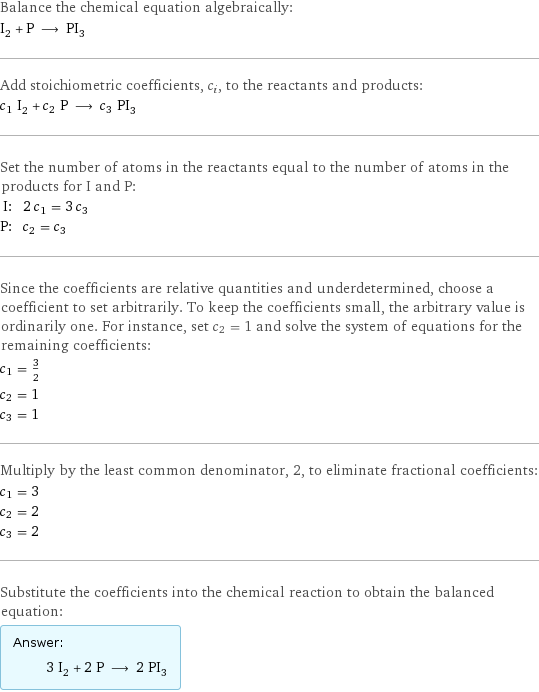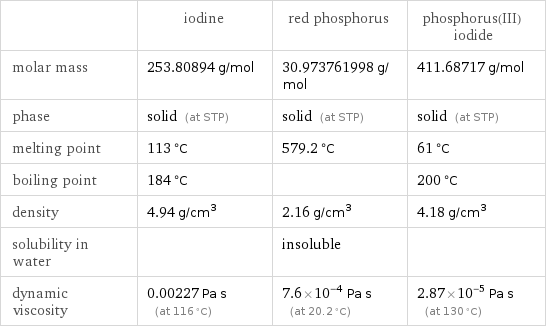Input interpretation

I_2 iodine + P red phosphorus ⟶ PI_3 phosphorus(III) iodide
Balanced equation

Balance the chemical equation algebraically: I_2 + P ⟶ PI_3 Add stoichiometric coefficients, c_i, to the reactants and products: c_1 I_2 + c_2 P ⟶ c_3 PI_3 Set the number of atoms in the reactants equal to the number of atoms in the products for I and P: I: | 2 c_1 = 3 c_3 P: | c_2 = c_3 Since the coefficients are relative quantities and underdetermined, choose a coefficient to set arbitrarily. To keep the coefficients small, the arbitrary value is ordinarily one. For instance, set c_2 = 1 and solve the system of equations for the remaining coefficients: c_1 = 3/2 c_2 = 1 c_3 = 1 Multiply by the least common denominator, 2, to eliminate fractional coefficients: c_1 = 3 c_2 = 2 c_3 = 2 Substitute the coefficients into the chemical reaction to obtain the balanced equation: Answer: | | 3 I_2 + 2 P ⟶ 2 PI_3
Structures

+ ⟶
Names

iodine + red phosphorus ⟶ phosphorus(III) iodide
Reaction thermodynamics
Enthalpy

| iodine | red phosphorus | phosphorus(III) iodide molecular enthalpy | 0 kJ/mol | -17.6 kJ/mol | -45.6 kJ/mol total enthalpy | 0 kJ/mol | -35.2 kJ/mol | -91.2 kJ/mol | H_initial = -35.2 kJ/mol | | H_final = -91.2 kJ/mol ΔH_rxn^0 | -91.2 kJ/mol - -35.2 kJ/mol = -56 kJ/mol (exothermic) | |
Equilibrium constant
![Construct the equilibrium constant, K, expression for: I_2 + P ⟶ PI_3 Plan: • Balance the chemical equation. • Determine the stoichiometric numbers. • Assemble the activity expression for each chemical species. • Use the activity expressions to build the equilibrium constant expression. Write the balanced chemical equation: 3 I_2 + 2 P ⟶ 2 PI_3 Assign stoichiometric numbers, ν_i, using the stoichiometric coefficients, c_i, from the balanced chemical equation in the following manner: ν_i = -c_i for reactants and ν_i = c_i for products: chemical species | c_i | ν_i I_2 | 3 | -3 P | 2 | -2 PI_3 | 2 | 2 Assemble the activity expressions accounting for the state of matter and ν_i: chemical species | c_i | ν_i | activity expression I_2 | 3 | -3 | ([I2])^(-3) P | 2 | -2 | ([P])^(-2) PI_3 | 2 | 2 | ([PI3])^2 The equilibrium constant symbol in the concentration basis is: K_c Mulitply the activity expressions to arrive at the K_c expression: Answer: | | K_c = ([I2])^(-3) ([P])^(-2) ([PI3])^2 = ([PI3])^2/(([I2])^3 ([P])^2)](../image_source/80b33e32d1c1479671347d1c89d8be09.png)
Construct the equilibrium constant, K, expression for: I_2 + P ⟶ PI_3 Plan: • Balance the chemical equation. • Determine the stoichiometric numbers. • Assemble the activity expression for each chemical species. • Use the activity expressions to build the equilibrium constant expression. Write the balanced chemical equation: 3 I_2 + 2 P ⟶ 2 PI_3 Assign stoichiometric numbers, ν_i, using the stoichiometric coefficients, c_i, from the balanced chemical equation in the following manner: ν_i = -c_i for reactants and ν_i = c_i for products: chemical species | c_i | ν_i I_2 | 3 | -3 P | 2 | -2 PI_3 | 2 | 2 Assemble the activity expressions accounting for the state of matter and ν_i: chemical species | c_i | ν_i | activity expression I_2 | 3 | -3 | ([I2])^(-3) P | 2 | -2 | ([P])^(-2) PI_3 | 2 | 2 | ([PI3])^2 The equilibrium constant symbol in the concentration basis is: K_c Mulitply the activity expressions to arrive at the K_c expression: Answer: | | K_c = ([I2])^(-3) ([P])^(-2) ([PI3])^2 = ([PI3])^2/(([I2])^3 ([P])^2)
Rate of reaction
![Construct the rate of reaction expression for: I_2 + P ⟶ PI_3 Plan: • Balance the chemical equation. • Determine the stoichiometric numbers. • Assemble the rate term for each chemical species. • Write the rate of reaction expression. Write the balanced chemical equation: 3 I_2 + 2 P ⟶ 2 PI_3 Assign stoichiometric numbers, ν_i, using the stoichiometric coefficients, c_i, from the balanced chemical equation in the following manner: ν_i = -c_i for reactants and ν_i = c_i for products: chemical species | c_i | ν_i I_2 | 3 | -3 P | 2 | -2 PI_3 | 2 | 2 The rate term for each chemical species, B_i, is 1/ν_i(Δ[B_i])/(Δt) where [B_i] is the amount concentration and t is time: chemical species | c_i | ν_i | rate term I_2 | 3 | -3 | -1/3 (Δ[I2])/(Δt) P | 2 | -2 | -1/2 (Δ[P])/(Δt) PI_3 | 2 | 2 | 1/2 (Δ[PI3])/(Δt) (for infinitesimal rate of change, replace Δ with d) Set the rate terms equal to each other to arrive at the rate expression: Answer: | | rate = -1/3 (Δ[I2])/(Δt) = -1/2 (Δ[P])/(Δt) = 1/2 (Δ[PI3])/(Δt) (assuming constant volume and no accumulation of intermediates or side products)](../image_source/9d8194938406f7e174ef78e78c5410b4.png)
Construct the rate of reaction expression for: I_2 + P ⟶ PI_3 Plan: • Balance the chemical equation. • Determine the stoichiometric numbers. • Assemble the rate term for each chemical species. • Write the rate of reaction expression. Write the balanced chemical equation: 3 I_2 + 2 P ⟶ 2 PI_3 Assign stoichiometric numbers, ν_i, using the stoichiometric coefficients, c_i, from the balanced chemical equation in the following manner: ν_i = -c_i for reactants and ν_i = c_i for products: chemical species | c_i | ν_i I_2 | 3 | -3 P | 2 | -2 PI_3 | 2 | 2 The rate term for each chemical species, B_i, is 1/ν_i(Δ[B_i])/(Δt) where [B_i] is the amount concentration and t is time: chemical species | c_i | ν_i | rate term I_2 | 3 | -3 | -1/3 (Δ[I2])/(Δt) P | 2 | -2 | -1/2 (Δ[P])/(Δt) PI_3 | 2 | 2 | 1/2 (Δ[PI3])/(Δt) (for infinitesimal rate of change, replace Δ with d) Set the rate terms equal to each other to arrive at the rate expression: Answer: | | rate = -1/3 (Δ[I2])/(Δt) = -1/2 (Δ[P])/(Δt) = 1/2 (Δ[PI3])/(Δt) (assuming constant volume and no accumulation of intermediates or side products)
Chemical names and formulas

| iodine | red phosphorus | phosphorus(III) iodide formula | I_2 | P | PI_3 Hill formula | I_2 | P | I_3P name | iodine | red phosphorus | phosphorus(III) iodide IUPAC name | molecular iodine | phosphorus | triiodophosphane
Substance properties

| iodine | red phosphorus | phosphorus(III) iodide molar mass | 253.80894 g/mol | 30.973761998 g/mol | 411.68717 g/mol phase | solid (at STP) | solid (at STP) | solid (at STP) melting point | 113 °C | 579.2 °C | 61 °C boiling point | 184 °C | | 200 °C density | 4.94 g/cm^3 | 2.16 g/cm^3 | 4.18 g/cm^3 solubility in water | | insoluble | dynamic viscosity | 0.00227 Pa s (at 116 °C) | 7.6×10^-4 Pa s (at 20.2 °C) | 2.87×10^-5 Pa s (at 130 °C)
Units
